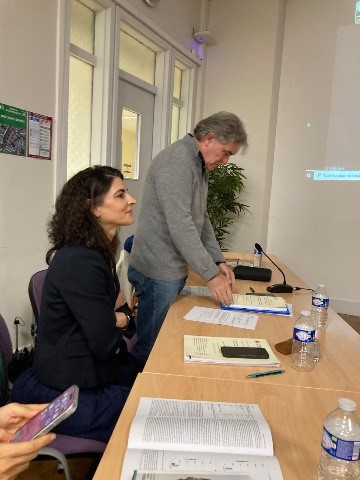A member of the QUALI-DEC project, she successfully defended her doctoral thesis on 21 November 2024 on the theme: “Mode of delivery in low- and middle-income countries: non-clinical factors influencing decision-making”.
Camille Etcheverry (midwife and member of the Quali-Dec project) has just been awarded her PhD in Public Health/Epidemiology from the Université Paris Cité, crowning a remarkable 3 years’ work, carried out under the direction of Alexandre Dumont (gynaecologist-obstetrician, director of research at the IRD, researcher at Ceped-Université Paris Cité and scientific coordinator of the Quali-Dec project) and the support of Ana Pilar Betran Lazaga (Medical Officer, WHO).
We would like to congratulate and thank her sincerely for her commitment and for her scientific and human contribution to the QUALI-DEC project.
She gave a brilliant defence of her thesis and unanimously won over the members of the Jury:
- Valérie BRIAND, Director of Research, Epicentre/MSF, Rapporteur
- Véronique FILIPPI, full professor, London School of Hygiene and Tropical Medicine, Rapporteur
- François GOFFINET, University Professor, Université Paris Cité, Examiner
- Henri-Jean PHILIPPE, University Professor, Université Paris Cité, Guest Member
- Ana Pilar BETRAN LAZAGA, medical officer, WHO , Guest Member
- Alexandre DUMONT, Director of Research, IRD, Thesis supervisor
Reminder: over the last 30 years, caesarean section rates have risen considerably, with no obvious benefit for maternal and neonatal health. In the absence of effective interventions, caesarean section rates will continue to rise, particularly in low- and middle-income countries. The QUALI-DEC project aims to implement non-clinical interventions to reduce non-medically justified caesarean sections in four countries: Argentina, Burkina Faso, Thailand and Vietnam.
The aim of this thesis was to gain a better understanding of the non-clinical factors leading to the increase in caesarean section rates in the 32 hospitals participating in the project. We assessed the maternal and organisational factors influencing the use of caesarean sections in a representative sample of women at low risk of caesarean section who had just given birth in the participating hospitals, using data from a cross-sectional survey. We used multilevel logistic regression models and propensity score matching analysis. Women’s preference for caesarean section, which was low in our sample although varying from country to country, more frequent among nulliparous women and motivated by fear of pain and childbirth, favoured recourse to caesarean section. Factors linked to the organisation of care, the availability of resources and hospital activity also influence the use of this procedure. Although identified in this research, these factors are not primarily responsible for the high caesarean section rates among low-risk women in hospitals. Other unmeasured factors such as the quality of care during labour and the heterogeneity of clinical practices are probably essential determinants to be taken into account. There is an urgent need to ensure that the decision-making process is based, in this context, on the interests of women in view of the risks and benefits of each mode of delivery, their expectations and their clinical situation. To achieve this, it is necessary to improve women’s experience of childbirth, encourage their involvement in decision-making about the mode of delivery and promote adherence to good practice by clinicians.



And for more information on QUALI-DEC: visit our website or download our application: www.qualidec.com/en or access our MOOC: mooc.qualidec.com







